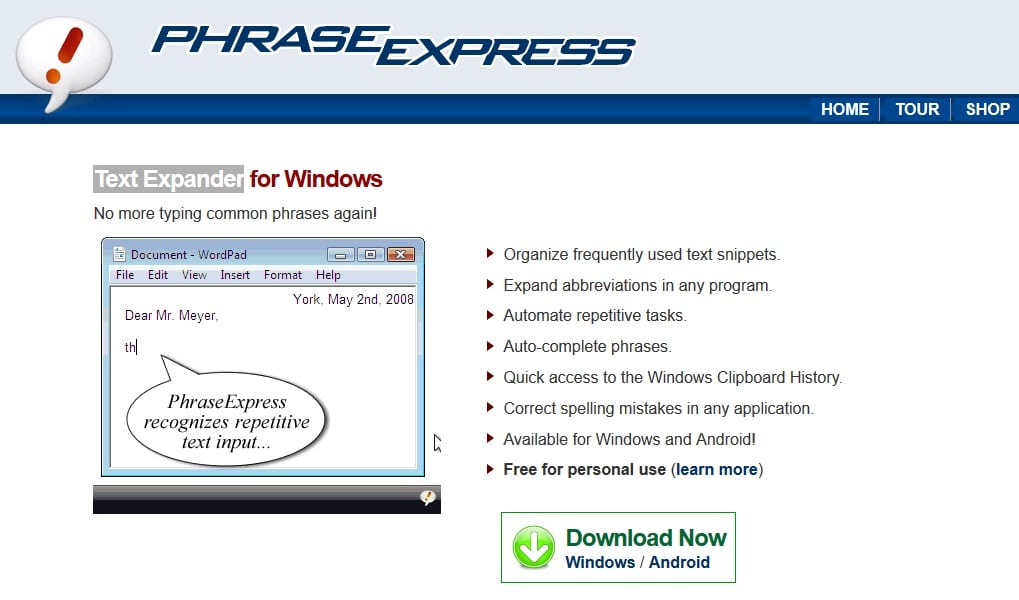

You can set an extension by using the "type" command followed by its own syntax. The third section in the YML document lists a Shell Command that you can use for that purpose. The Shell extension lets you write commands that can be executed using the Command Prompt, PowerShell and other shells. The Date example which I mentioned uses the "Date" extension. ExtensionsĮspanso supports extensions, commands that you can customize. You can write your matches in any order you want to. Note: I use the word section just as a reference to the order of the commands that the default configuration file lists them in.
Text expander linux how to#
The documentation I linked to above, explains how to add a match for a similar "Time" match. First you set the keyword as usual, then you declare a variable called "mydate", which contains the type (extension) and the parameter to calculate it. The syntax for it may appear to be complicated, almost like a program code. Look at YML document's "Dates" section this one has a trigger that will add the current date in the format "month/date/year (US format). to replace the variable with the date and time. Refer to the official documentation about Word Triggers to avoid this issue. You can use matches without the colon symbol, but it will replace words which spell similarly. Will it replace other words which I type? No, that's why the : symbol is used, to prevent words being replaced by accident. This may not be practical in day-to-day usage, but the option is there, in case you want to use it.Īll the above examples are static matches, as in, the replacement word or phrase never changes.
Text expander linux full#
Replace word with the keyword you want and the /path/image.ext with the full path of the image's location, followed by the name of the picture and its extension. You can even replace a text with an image, the syntax is slightly different. That's incredibly easy, isn't it? You can use it to add email signatures, URLs, HTML Tags, commonly used phrases, responses, etc, and save some time. Now type :ghx and it should be replaced with. Save the document, exit Espanso and start it again. To make it easy, you can just copy the "espanso" trigger, paste it in a new line and edit it. Write a new trigger word and choose a replacement phrase. The first one is correct, the latter won't trigger the program. The other rule is to remember to use the : symbol. So if your match isn't being triggered correctly, check the spacing in the syntax. The indentation is necessary for the syntax to work.

That's the match trigger and replacement which I mentioned in my example. Look at the highlighted section in the screenshot below. Espanso uses YAML syntax, which is very user-friendly. This folder contains a "default.yml" file.

Go to the application's "Roaming" folder in your User directory. If you haven't guessed it already, Espanso is the Italian word for Expanded. In this case ":espanso" is the keyword and "Hi There" is the replaced text. Type the word :espanso and it will magically be replaced with the phrase "Hi there!". The official wiki explains the technical details rather well, but I'll demonstrate how it works below for your convenience.įire up a text editor or browser, or any other program that accepts text input. MatchesĮspanso uses the concept of Matches (keyword recognition) i.e., when you type a word that's present in the program's settings, it triggers the application to substitute the keyword with its configured replacement. Right-clicking on it allows you to disable it or exit the program.Įspanso works in all applications that I tried it in including Notepad, Word, Firefox, Thunderbird, and more. Start the program and you should see an icon on the system tray. properly I think it requires the restart to enable the "PATH" correctly. You will also need to restart the computer to get the program working.
Text expander linux mac#
Espanso is an open source text template program for Windows, Mac and Linux that helps users save time.ĭuring the installation, you have the choice to add Espanso to "PATH" (Windows System Variable) and to enable it to auto-start with Windows.


 0 kommentar(er)
0 kommentar(er)
